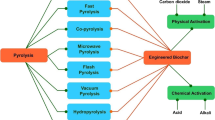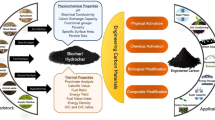Abstract
Natural pinewood and delignified pinewood were functionalized into bio-adsorbent materials for water remediation, particularly for removing copper ions (Cu2+). Wood was functionalized by esterification with maleic anhydride and citric acid, which increased the content of carboxyl functional groups for the chelation of copper ions. The effects of wood delignification and functionalization on the bio-adsorbents’ adsorption capacity for copper ions in water were investigated. Cu2+ adsorption capacity and COOH grafting density showed an almost linear correlation with wood-based bio-adsorbents. Although the delignification of wood did not impact the adsorption capacity of the delignified wood functionalized with maleic anhydride, it significantly enhanced the Cu2+ adsorption capacity (attaining 0.22 mmol/g) of the delignified wood functionalized with citric acid (with a COOH content of 0.50 mmol/g). Moreover, the delignified wood functionalized with citric acid showed only a 10% loss in adsorption capacity after three regeneration cycles with acetic acid, showing a promising application as a bio-adsorbent material for the removal of copper ions from water.









Similar content being viewed by others
Data availability
Data can be made available upon request.
References
Agarwal A, Upadhyay U, Sreedhar I et al (2020) A review on valorization of biomass in heavy metal removal from wastewater. J Water Process Eng 38:101602. https://doi.org/10.1016/j.jwpe.2020.101602
Ahmed MJK, Ahmaruzzaman M (2016) A review on potential usage of industrial waste materials for binding heavy metal ions from aqueous solutions. J Water Process Eng 10:39–47. https://doi.org/10.1016/j.jwpe.2016.01.014
Beims RF, Arredondo R, Carrero DJS et al (2022) Functionalized wood as bio-based advanced materials: properties, applications, and challenges. Renew Sustain Energy Rev 157:112074. https://doi.org/10.1016/j.rser.2022.112074
Chowdhury S, Mazumder MAJ, Al-Attas O, Husain T (2016) Heavy metals in drinking water: occurrences, implications, and future needs in developing countries. Sci Total Environ 569–570:476–488. https://doi.org/10.1016/j.scitotenv.2016.06.166
Cooper PA (1996) Rate of swelling of vacuum-impregnated wood. Wood Fiber Sci 28:28–38
Deliyanni E, Arabatzidou A, Tzoupanos N, Matis K (2012) Adsorption of Pb2+ using mesoporous activated carbon and its effects on surface modifications. Adsorpt Sci Technol 30:627–645. https://doi.org/10.1260/0263-6174.30.7.627
Deliyanni EA, Kyzas GZ, Triantafyllidis KS, Matis KA (2015) Activated carbons for the removal of heavy metal ions: a systematic review of recent literature focused on lead and arsenic ions. Open Chem 13:699–708. https://doi.org/10.1515/chem-2015-0087
Demirbas A (2008) Heavy metal adsorption onto agro-based waste materials: a review. J Hazard Mater 157:220–229. https://doi.org/10.1016/j.jhazmat.2008.01.024
Gu Y, Ye M, Wang Y et al (2020) Lignosulfonate functionalized g-C3N4/carbonized wood sponge for highly efficient heavy metal ion scavenging. J Mater Chem A 8:12687–12698. https://doi.org/10.1039/d0ta00382d
Hou QX, Chai XS, Zhu JY (2005) Determination of the carboxyl groups in fibers by headspace gas chromatography. Chung-Kuo Tsao Chih/china Pulp Pap 24:5–9
Jiang F, Li T, Li Y et al (2018) Wood-based nanotechnologies toward sustainability. Adv Mater 30:1–39. https://doi.org/10.1002/adma.201703453
Sehaqui H, de Larraya UP, Liu P et al (2014) Enhancing adsorption of heavy metal ions onto biobased nanofibers from waste pulp residues for application in wastewater treatment. Cellulose 21:2831–2844. https://doi.org/10.1007/s10570-014-0310-7
Shui T, Feng S, Yuan Z et al (2016) Highly efficient organosolv fractionation of cornstalk into cellulose and lignin in organic acids. Bioresour Technol 218:953–961. https://doi.org/10.1016/j.biortech.2016.07.054
Vitas S, Keplinger T, Reichholf N et al (2018) Functional lignocellulosic material for the remediation of copper(II) ions from water: Towards the design of a wood filter. J Hazard Mater 355:119–127. https://doi.org/10.1016/j.jhazmat.2018.05.015
Xu X (2020) Wood modification with resin impregnation technology for value-added services. SVOA Mater Sci Technol 2:09–21
Acknowledgments
The authors gratefully acknowledge the Nanofabrication Facility at Western University for assistance with the SEM measurements. The author R.F.B acknowledges the Coordination for the Improvement of Higher Education Personnel (CAPES) for providing the scholarship for the Ph.D. program (Process Number 88881.174355/2018–01).
Funding
This research was funded by Agriculture and Agri-Food Canada’s AgriScience Program through the BioMass Canada cluster led by BioFuelNet and by the Natural Sciences and Engineering Research Council of Canada (NSERC) through the Discovery Grant awarded to C. Xu. The author R.F.B acknowledges the Coordination for the Improvement of Higher Education Personnel (CAPES) for providing the scholarship for the Ph.D. program (Process Number 88881.174355/2018–01).
Author information
Authors and Affiliations
Contributions
CX proposed the initial idea and supervised the research. RFBeims designed and conducted the experiments, materials preparation, and characterizations. All authors analyzed and discussed the results and contributed to manuscript preparation.
Corresponding author
Ethics declarations
Conflict of interest
The authors have no competing interests to declare that are relevant to the content of this article.
Additional information
Publisher's Note
Springer Nature remains neutral with regard to jurisdictional claims in published maps and institutional affiliations.
Rights and permissions
Springer Nature or its licensor (e.g. a society or other partner) holds exclusive rights to this article under a publishing agreement with the author(s) or other rightsholder(s); author self-archiving of the accepted manuscript version of this article is solely governed by the terms of such publishing agreement and applicable law.
About this article
Cite this article
Beims, R.F., Kermanshahi-pour, A. & Xu, C.C. Functionalizing natural wood and delignified wood into bio-adsorbents for removal of Cu2+ from water. Cellulose 30, 8037–8047 (2023). https://doi.org/10.1007/s10570-023-05381-8
Received:
Accepted:
Published:
Issue Date:
DOI: https://doi.org/10.1007/s10570-023-05381-8




